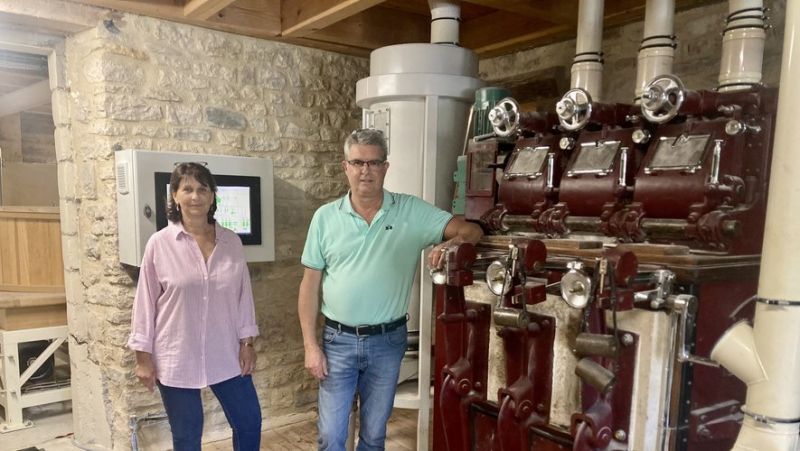The Moulin de Colagne, in Lozère, a family story and tradition for over a hundred years

Jean-Pierre Constans et Chantal Rech sont les cogérants du Moulin de Colagne. MIDI LIBRE – STEPHANIE BOULOIR
Après son grand-père et son père, Jean-Pierre Constans continue de fabriquer de la farine à l’ancienne, avec des meules en pierre.
In the Colagne mill, the flint millstones still turn, reducing the cereals into flour. Time has passed, like the water of the Colagne running under the bridge in front of the building.
Three generations
It was by the grandparents of Jean-Pierre Constans, in 1917, that the mill, the first traces of which date back to the 13th century, was purchased. "They were farmers in Paris. There were farms in the capital at that time. But they wanted to leave the city. The family had roots in Trélans, so this mill was bought. My grandfather came to work there some time later, upon demobilization." The mill then processes the cereals from the surrounding area. A cow farm is attached.
After the grandfather, the father takes over. Then, it was the turn of Jean-Pierre Constans, in 1989. For more than a century, the family mill has continued to operate. Of course, developments have occurred. Hydraulic power has been replaced by electricity. Buildings have been added to allow the reception of cereals, the carrying out of analyses, compliance with new standards, scrupulous traceability… Automation has changed certain tasks. But the manufacturing method has not changed.

The Moulin de Colagne, in the delegated commune of Chirac. FREE MIDI – STEPHANIE BOULOIR
The traditional method
Until 1945, France was a pioneer in millstones, recalls Jean-Pierre Constans: "It exported them all over the world. Then, with industrialization, grinding stones were replaced by steel cylinders." Trained in milling and management, Jean-Pierre Constans wants to go against the tide: "French milling had lost all its export markets. All the big manufacturers have turned to the French market. The business was small, I thought making millstone flour was a way out." Millstone flour, "which retains all the nutrients and all the protein base", and organic flour will be preferred.
Over time, Jean-Pierre Constans and Chantal Rech, co-managers, increased the capacity of the site, adding millstones to create a second mill in the building. Some machines from the first half of the 20th century are still in use, restored, such as the Soder, which allows the flour to be refined after passing through the millstone, or the Planshister, which sifts the flour . The latter sits alongside its modern counterpart, installed for the new mill.
Organic
Currently, 45 tonnes of grain enter the mill every day (from the South-West), and 37 tonnes of flour come out. That is, per year, 8,000 tonnes of cereals are transformed into 6,000 tonnes of flour. The 2,000 tonnes of residue will become livestock feed. The Moulin de Colagne offers around thirty different flours, from white flour to wholemeal flour, from wheat to einkorn, buckwheat, or even rye. The vast majority of these flours are sold to bakeries or flour mills. 35 % of turnover is achieved through export, particularly in Spain, where the Moulin de Colagne was able to make its place in a new market.
Sales to individuals
To respond to the demand that has emerged during the Covid-19 crisis, the Moulin de Colagne developed sales to individuals, direct, at the mill, in drive. Organic flour (T65, T80, T150, einkorn, rye, gingerbread mix) is packaged in 1 and 5 kg bags by the Clos du nid workshops. To buy flour, contact the mill on 04 66 32 70 03.
This Saturday, the Moulin de Colagne is celebrating its centenary (the initial celebration had been postponed due to the Covid-19 crisis). He will receive his customers, his suppliers, his partners and will present to them the latest work (investments of 5.20 million euros, to improve the storage of cereals and flour, a mixing station, a new laboratory, additional millstones…). Evolution has allowed the Moulin de Colagne to go from eight to 20 employees in recent years, and to weather crises. Here he is ready to tackle the future, so that century-old know-how continues.
I subscribe to read more




